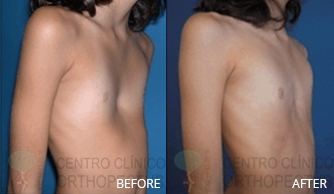Pectus Carinatum and Excavatum
Studying and providing pectus care since 1977 THE WORLD’S LARGEST EXPERIENCE IN THE CONSERVATIVE TREATMENT OF THORACIC DEFORMITIES
PECTUS is not a disease (see FAQ 1). Pectus is a group of deformities that affects millions of people around the world, but it is not known by society as the one who has the problem hides it.Pectus deformities are very common [see article] and they are not only a cosmetic problem. They also imply psychological problems to the patients and their families, deserving a rational approach and a social discussion for the benefit of people who have the condition.
Computed tomography is very useful for researching the development of pectus deformities (see article). On the other hand, clinical photographs were found to represent a simpler, more efficient, harmless and less expensive method of evaluating treatment results (see article).
Pectus carinatum and excavatum are complex deformities anatomically subdivided into several and sometimes mixed types of various degrees of severity. Photographic documentation is the ideal method to demonstrate the several aspects of protrusion and depression components of a given deformity, and for medical control of complications like overcorrection and skin irritation as well. Clinical photographs must be compared always from the same angle.
The results shown in this site do not mean that the same results will happen to patients with similar deformities. The examples here shown are of patients who followed properly the medical instructions during treatment and intend to demonstrate that bone and cartilage remodeling of the anterior chest wall – a malleable region – can occur, avoiding surgery.
Medical assistance is essential for treatment progress and to prevent complications, like overcorrection and worsening of skin irritation (see article). Patient’s will power and persistence in a long term period (one or more years) are essential for a successful DR method treatment.



